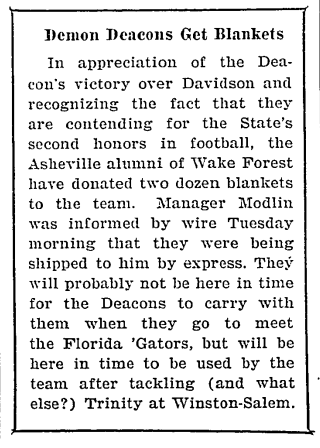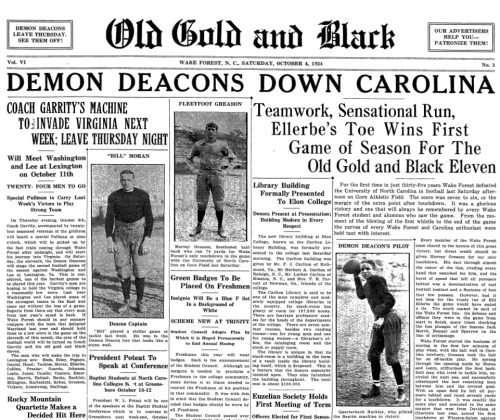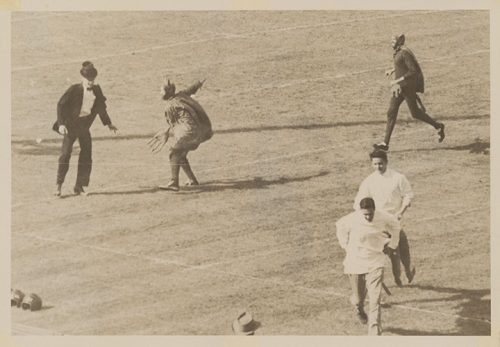Did you catch Director of Special Collections and Archives Tanya Zanish-Belcher’s WFDD interview about the history of the Demon Deacon (August 30, 2023)? As Tanya mentions, SCA staff and other researchers are working on a timeline of Demon Deacon history. This post captures a few notable moments from the Old Gold and Black archive. Thanks to Finley Turner for compiling this research. Email us at archives@wfu.edu to share more stories, dates, or memories of the mascot.
The history of Wake Forest’s distinctive Demon Deacon mascot is a topic of perennial interest for the community and visitors to ZSR’s Special Collections and Archives. After all, a spirited, larger-than-life church deacon who, these days, prefers to travel by motorcycle begs some questions.
University history, athletics materials, magazine articles, and recent media all highlight key moments in the Demon Deacon’s origin story. Generally, researchers agree that the nickname appeared first in the context of football in the 1920s, and the inspiration for a mascot image appeared later in the 1930s and 1940s. Through a survey of the Old Gold and Black digital collection, SCA staff have tracked milestones in the initial naming process.
What’s in a Name?

Early sports commentary often referred to Wake Forest teams as “Old Gold and Black” or “Baptists.” The school colors recall a short-lived tiger mascot. “Baptists” acknowledged the school’s affiliation and hyped match-ups with rival “Methodists” (Duke), “Christians” (Elon), Quakers (Guilford), and “Presbyterians” (Davidson). The shift from “fighting Baptists” to “Demon Deacons” did not happen overnight, and the evolution of the winning moniker is perhaps best documented in the pages of the student paper.
Sports headlines dominated in the early 1920s. Student reporters, especially those covering football, celebrated top players with generous descriptions. A November 11, 1921 article described future team Captain George Heckman (’23) “earning the title ‘demon end,’ and together with ‘Johnnie’ Johnson, his running mate, composing the smoothest working and most dangerous pair of ends in North Carolina.” Another article on the same cover page praised the football team’s newly appointed manager, C.P. Poole (’23), as “a demon for work.” Later in 1922, the paper described a center who “played like a demon veteran . . . and hit like a bull butts.” These instances establish “demon” in the context of fierceness, hard work, and skill.

The school was ready for some wicked good football, but it would take a couple more seasons. The team’s record in 1921 was 2-8 and 1922 was only marginally better. Old Gold and Black headlines captured efforts to build a team and an image. An October 20, 1922 lead story echoed the old nickname and hinted at the new with “Baptist Captain Rallies His Battling Deacons and Evens the Count in Final Chapter.” Reporters also used “Fighting Deacons” in at least two headlines that season. That modifier didn’t stick and around the same time was famously embraced by Notre Dame’s Fighting Irish.
Alliteration for the Win

Eventually, alliteration triumphed as did the team. In the fall of 1923, Wake football excelled under Coach Henry Garrity. Old Gold and Black, under the leadership of student editor Mayon Parker (’24), published over a dozen articles touting the “Demon Deacons.” The first instance this survey located was in an October 26, 1923 headline “Demon Deacons Get Blankets.” The brief article about commemorative blankets gifted from an alumni appears below the lead story about a win over Davidson. The casual shift implies that “demon deacon” was a somewhat familiar term. Perhaps, in use on the field as anecdotes suggest but not as often in print up to this point.
The new nickname truly takes hold after Wake’s big win over Duke, then known as Trinity, on November 10, 1923. The annual matchup was in Winston-Salem that year, long before Wake’s campus moved. The Friday before on November 9, 1923, the paper reported on “Coach Garrity and his demon deacons” traveling from the Raleigh area “by special train or by auto” in preparation for the Saturday game. The following Friday’s edition celebrated how “Coach Garrity’s Demon Deacons fought their way to a 16 to 9 victory over the Trinity Blue Devils in Winston-Salem last Saturday before an estimated crowd of 4,500 enthusiastic fans.” That edition refers to “demon deacons” at least three more times. Old Gold and Black published nearly a dozen more articles that season with some variation of “demon deacons.” The name showed staying power in coverage of the triumphant 1924 basketball season. The following school year, the resounding October 4, 1924 headline “Demon Deacons Down Carolina” celebrated a long-awaited win. The Demon Deacons were here to stay.

A Devilish Match-Up

National sports reporting from the time reflects branding trends of various colleges in the 1920s. Several notable ACC mascots started their journeys during this time, including the arch rival in Durham. The Story of the Blue Devil recounts Duke’s concerted naming effort between 1922 and 1923. According to the school, the editor of their student paper made the executive decision to refer to athletics teams as Blue Devils. The move was regarded at Trinity as both rebellious as a school with religious affiliation and noble in its loose reference to “the Blue Devils of France,” famed World War I heroes. The November 16, 1923 Old Gold and Black issue that celebrates the win over Trinity saw the potential for a great mascot rivalry when it reported, “the Demon Deacons left nothing but Blue bruises for the Trinity Blue Devils.” The early years of these clever and paradoxical mascots run parallel and may have helped to solidify the name’s staying power.
Putting a Face to a Name
Twenty years later, Wake embraced its Demon Deacon identity by putting a face to the name. In “Who is the Demon Deacon?” Wake Forest Magazine’s Kerry M. King paints a clear picture of how the mascot’s image evolved. In the 1930s, the band director asked drum major, Allie Hayes (’35), to wear an outfit reminiscent of a Baptist minister. In 1941, Jack Baldwin (’43) appeared as the first on-field mascot, wearing a top hat and riding the Carolina ram. In 1948, Howler art editor, Glenn Willis (’49), introduced the caricatured Deacon as part of a playful yearbook theme that personified “the living spirit of Wake Forest College.” The language leans on the origins of “demon” as a supernatural spirit who inspires and guides – with a bit of competitive mischief in the mix. The complete Demon Deacon costume appeared in the 1980s.
Through the years, the Demon Deacon persona and image have evolved along with the Wake Forest community. The mascot remains a nod to the school’s history and an embodiment of values that guide its growth, including determination and spirit.

9 Comments on ‘Old Gold and Black Archive Reflects 100 Years of “Demon Deacons”’
Congratulations for this interesting and informative report.
Thanks Emily!
Great blog post! Maybe we should highlight the 100 years of the Demon Deacon at Homecoming this year…
I loved reading this. Thanks Emily!
Thanks for this interesting post! What a fascinating journey our mascot has been on to find a moniker with staying power! (Now I’d like to know how often they get a new “Demon Deacon” suit, and who IS the student that wears it!)
We had a question from a patron about the origin and history of the mascot once and I struggled to find a comprehensive write up about it – this is perfect!
Now I’m curious about where in W-S there was a stadium that could hold 4,500 people in 1923 . Looks like it was too early for Bowman Gray. Time to check Sanborn maps??
Thanks for pulling together numerous writings and making a one cohesive document with helpful visuals!
Great post, and I love all the links to do more reading. Thank you, Emily and Finley!